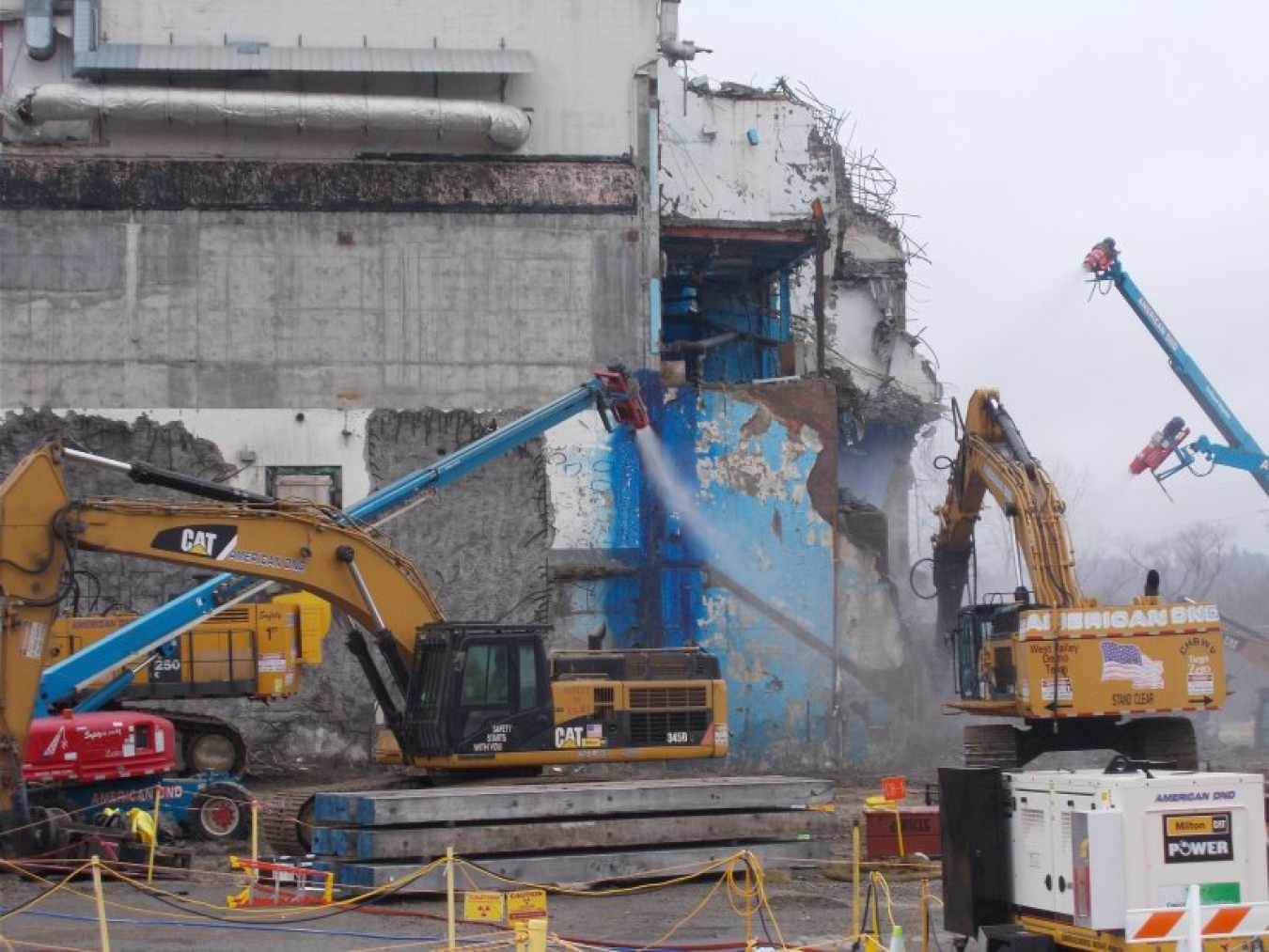Overview
The WVDP is an approximate 150-acre area located within the Western New York Nuclear Service Center (WNYNSC), which is a 3,338-acre site located 35 miles south of Buffalo, New York. The site is owned by the New York State Energy Research and Development Authority (NYSERDA) and is home to the only commercial SNF reprocessing facility to operate in the United States. In 1962, Nuclear Fuel Services, Inc., entered into agreements with the AEC and New York State to construct, license, and operate the commercial reprocessing plant, along with two associated waste burial grounds and an underground set of four tanks for reprocessing waste. The fuel reprocessing plant operated from 1966 to 1972, processing 640 metric tons of SNF and generating over 600,000 gallons of liquid HLW.
In 1980, Congress passed the West Valley Demonstration Project (WVDP) Act, which required DOE to conduct a HLW management demonstration project at the WNYNSC and transport the HLW to a federal repository for disposal. The WVDP Act directed DOE to:
- Solidify the HLW in a suitable form for transportation and disposal
- Develop containers suitable for the HLW’s disposal
- Transport the solidified waste to a federal repository for disposal as soon as feasible.
- Dispose of LLW and TRU waste produced by the HLW solidification process*.
- Decontaminate and decommission the tanks and other facilities used at the WNYNSC in which the HLW was solidified, the facilities used in the waste’s solidification, and any material and hardware used in connection with the WVDP
* Since WVDP TRU waste was derived from commercial nuclear fuel reprocessing, it is considered non-defense TRU waste. DOE refers to this waste stream as Greater than Class C (GTCC)-like waste.
DOE chose vitrification as the technology for solidifying the HLW, and DOE completed vitrifying the HLW in 2002. The resulting 278 canisters of vitrified HLW are currently stored on-site. Since 1997 DOE has been disposing of LLW at off-site disposal facilities; processing and packaging both contact-handled and remote-handled GTCC-like waste; and deactivating, decontaminating, and removing unneeded facilities.
In 2010, DOE and NYSERDA published, in compliance with the National Environmental Policy Act, a joint final environmental impact statement that addressed both DOE’s completion of the WVDP and NYSERDA’s decommissioning and/or long-term stewardship of the WNYNSC. The same year, DOE issued a ROD and NYSERDA issued a Statement of Finding to proceed with a phased decision-making approach for remaining cleanup activities. Phase 1 covers soil remediation and disposition of the remaining facilities. Phase 2 will address the four underground waste tanks, the two on-site disposal areas, the non-source area of a groundwater plume, and several other minor facilities. DOE and NYSERDA intend to complete the remaining decision-making with its Phase 2 decision in a supplemental environmental impact statement.
DOE has a strong public outreach program at WVDP including conducting Quarterly Public Meetings (QPMs) and participating in eight monthly meetings with the West Valley Citizen Task Force (CTF). During the planning of the Phase 1 decommissioning decision, DOE discussed the approach at both the QPMs and CTF meetings. DOE provides updates of the status of ongoing Phase 1 decommissioning activities at both A worker gets trained on how to get suited up for PPC-S decontamination work. Post-2032 Cleanup Scope Remaining work at West Valley post-2033 will focus on disposal of “orphan” waste (waste which currently does not have a pathway for disposal) and completion of Phase 2 decommissioning activities. DOE currently anticipates completing cleanup activities at West Valley by 2043. the QPM and CTF meetings. DOE also provides a status of site progress at the monthly Ashford Town Board meetings. This year, the site held an in-person informational session for Town of Ashford residents to discuss the upcoming demolition of the Main Plant Process Building (MPPB).

Calendar Year 2022 Accomplishments
- Began demolition of the last remaining major facility at the site - the Main Plant Process Building - meeting an EM 2022 priority
- Completed demolition of the Load-In/Load-Out Facility, the last remaining ancillary support facility
- Completed the Permeable Treatment Wall Soil and Structure Removal Project, and re-instated rail operations
Key Regulatory Milestones 2023–2033
- None
Planned Cleanup Scope 2023–2033
Work underway at West Valley is now focused on completing demolition of the MPPB. By 2025, DOE expects to complete the removal of the above grade portion of the MPPB.
By 2025, DOE and NYSERDA intend to make an integrated decision on the path forward for the Phase 2 decommissioning activities and/or long-term stewardship of the WNYNSC. Phase 2 decommissioning decisions will address the four underground tanks, the two waste disposal areas, the non-source area of the groundwater plume, and several other facilities.
By the end of 2030, DOE expects to complete the decommissioning of the below-grade portions of the MPPB and the Vitrification Facility, where above ground demolition was completed in 2019. DOE will also complete the decommissioning of the site’s radioactive water treatment system, including four active lagoons and one closed lagoon. By the end of 2032, DOE will complete soil remediation efforts in Waste Management Area-1 and Waste Management Area-2.
If a disposal option for GTCC-like waste is available, DOE could, by the end of 2033, complete the processing, packaging, shipment, and disposal of GTCC-like waste and removal of remaining waste processing facilities, such as the Remote-Handled Waste Facility, once GTCC- like waste shipping and disposal is complete.
Post-2032 Cleanup Scope
Remaining work at West Valley post-2033 will focus on disposal of “orphan” waste (waste which currently does not have a pathway for disposal) and completion of Phase 2 decommissioning activities. DOE currently anticipates completing cleanup activities at West Valley by 2043.

